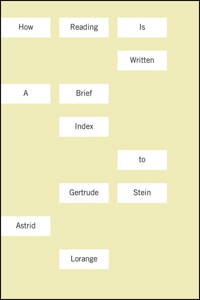
How Reading is Written: A Brief Index to Gertrude Stein by Astrid Lorange
a review by Dale Engass
Astrid Lorange
Wesleyan University Press
240 pages
$24.95
Indexical Reading
While researching her new critical work How Reading is Written: A Brief Index to Gertrude Stein (Wesleyan, 2014), Astrid Lorange kept a file on her computer titled “violent and hygienic metaphors” (243). The quotations collected in the file register a pervasive desire in Stein criticism to see Stein as, in the words of Mina Loy, “a Curie / of the laboratory / of vocabulary” who returns us to “a radium of the word” (ibid.). For Lorange, such tropes are an “unconscious revelation of a reader’s desire – a desire for a language experience unattached to the residues and sediments of meaning” (ibid.). Indeed, the process of reading – of how readers engage with and produce Stein’s texts – is a fundamental question for How Reading is Written, and Lorange’s generative approach makes a convincing case for a criticism that thinks alongside a text instead of seeking to delimit through exegesis.
Lorange employs the organizing principle of the index – the paratextual apparatus that both “functionally organizes conceptual and referential material” and “[documents] the contingencies and unexpected convergences of a text” (3). That is, indexes are both organizing and ambiguous, pointing their reader in several unexpected directions at once. The book consists of ten sections in alphabetical order that use a particular term (Bodies, Food, Grammar, Queering, Repetition, etc) as a jumping off point to explore affinities between Stein’s philosophical and compositional concerns and the work of a wide range of thinkers, from Alfred North Whitehead and William James, to Lee Edelman and Deleuze and Guattari. (As it is itself an Index, How Reading is Written does not contain its own index; rather, helpful cross-references occasionally appear in the margins pointing the reader to specific sections and page numbers.) Lorange does not propose to use the works of these theorists to explain away the difficulty or stabilize the meaning of Stein’s writing; rather, she posits the index as “an alternative mode to literary criticism” in which “one uses the index to move laterally and variously across a network of affinitive texts” (6).
One of the real pleasures of reading this study is witnessing Lorange’s lateral movement – her deftness and range as a writer and thinker. In remarkably lucid prose, Lorange transitions nimbly from the process theory of Whitehead, to Michel Serres’ concept of the parasite, new materialist reassessments of human agency, concise primers on Queer Theory and Homographesis, Sianne Ngai’s readings of “cuteness” and “interestingness” – all while navigating the density of Stein’s plays, the poems of Tender Buttons, the monumental prose of The Making of Americans, and essays such as “Composition as Explanation.” The book is thus both a comprehensive mapping of Stein’s varied compositional terrain and an immensely useful guide to a set of theories concerned with the concept of relation as an event-like, constructive entity. Stein’s texts, Lorange argues, make things happen: language for Stein is not a tool for representing reality but a part of the fabric of reality itself.
In its lateral, affinitive method, How Reading is Written marks an important challenge to what Lorange calls “the dominance of hermeneutical approaches to reading writing,” which bring to Stein “determinate notions of indeterminacy” (9). Even a critic as inventive and attentive as Marjorie Perloff skews toward a recuperative reading of Stein by “finding ways to get meaning into the language” (109). Lorange, on the other hand, insists that Stein’s infamous obscurity “is not meant in the sense of obscuring…but as an ontological position: for the most part, experience consists of partial, suggestive, and half-glimpsed entities” (10-11). Lorange’s Stein is interested in what Serres might call a fuzzy set; her writing is not concerned with extracting meaning, but with the actuality of language in its riddling opacity.
Lorange introduces as well a crucial correlate to the familiar claim that readers co-write, or co-produce, the texts they read: a reading, this study makes clear, is not undertaken in isolation but in conversation with many diverse texts. Any reading, to borrow from the aforementioned Deleuze and Guattari, is an assemblage, a collection of multi-directional readings that are brought to bear on a particular work, or body of work. Lorange beautifully displays the power of a criticism that both acknowledges affinities between diverse texts and enacts the generative potential of an indexical approach. How Reading is Written is a pivotal addition not only to Stein scholarship, but also to literary criticism in general. It presents innumerable possibilities for how to read writing, not meaning.
